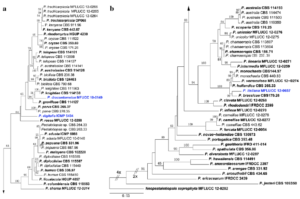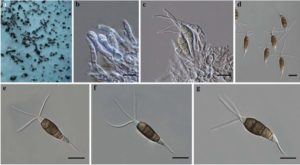Pestalotiopsis italiana Maharachch., Camporesi & K.D. Hyde, in Liu et al., Fungal Diversity: 10.1007/s13225-015-0324-y, [16] (2015)
Index Fungorum number: IF550944, MycoBank number: MB 550944; Facesoffungi number: FoF00458;
Etymology – named after the country, where itwas collected.
Holotype – MFLU 14–0214
Saprobic on Cupressus glabra. Sexual morph Undetermined. Asexual morph Conidiomata pycnidial in culture on PDA, globose, scattered or gregarious and confluent, semi-immersed, dark brown, up to 200μm diam. Conidiophores septate near the base, branched, subcylindrical. Conidiogenous cells discrete, subcylindrical or ampulliform to lageniform, smooth-walled, percurrently proliferating 1–3 times. Conidia 26–35×8– 11 μm (x̄ = 30×9.6 μm, n = 20), ellipsoid, straight to slightly curved, 4-septate, basal cell conic with obtuse end, hyaline, thin-walled and verruculose, 5–7 μm long (x̄ = 6 μm), with three median cells, doliform to cylindrical, with thick verruculose walls, constricted at the septa, concolourous, olivaceous, septa and periclinal walls darker than the rest of the cell, wall rugose, together 18–28 μm long (x̄ = 23 μm) second cell from base 5.5–8.5 μm (x̄ = 6.7 μm); third cell 6–9 μm (x̄ = 7 μm); fourth cell 6–9 μm (x̄ = 7.7 μm); apical cell hyaline, conic to subcylindrical 4–6.5 μm long (x̄ = 4.9 μm); with 2–5 tubular apical appendages (mostly 3–4), arising from the apex of the apical cell (rarely 1 appendage arising from just above the septum separating upper median and apical cell), 20–40 μm long (x̄ = 32 μm); basal appendage present 6–10 μm (x̄ = 7 μm).
Culture characters – Colonies on PDA reaching 50–60 mm diam. after 7 d at 25 °C, with an undulate edge, whitish to pale grey-coloured, with dense aerial mycelium on surface, and black, gregarious conidiomata; reverse similar in colour.
Material examined – ITALY, Province of Forlì-Cesena, Camposonaldo, Santa Sofia, on dead twigs of Cupressus glabra, 24 November 2011, E. Camporesi IT051 (MFLU 14–0214, holotype); ex-type living culture MFLUCC 12–0657.
GenBank Accession Numbers – ITS: KP781878; TEF: KP781881; TUB: KP781882.
Notes – Pestalotiopsis italiana was collected on dead twigs of Cupressus glabra in Italy, and forms a sister clade to P. brassicae (CBS 170.26), P. hollandica (CBS 265.33) and P. verruculosa (MFLUCC 12–0274) which were isolated from seeds of Brassica napus L. in New Zealand, Sciadopitys verticillata (Thunb.) Siebold & Zucc. in the Netherlands and Rhododendron sp. in China, respectively Pestalotiopsis italiana overlaps morphologically with P. verruculosa. However, in the phylogenetic analyses it formed a distinct lineage apart from P. verruculosa (Fig. 1) and geographically they are clearly distinct.

Fig. 1 Phylogram generated from Maximum Likelihood analysis based on combined ITS, β-tubulin and TEF gene regions of Pestalotiopsis. Maximum likelihood bootstrap support values greater than 50 % are indicated above or below the nodes. The ex-types (reference strains) are in bold; the new isolates are in blue. The tree is rooted with Neopestalotiopsis saprophyta MFLUCC 12-0282

Fig. 2 Pestalotiopsis italiana (holotype) a Conidiomata on PDA b, c Conidiogenous cells d–g Conidia. Scale bars: b–g=10μm.
